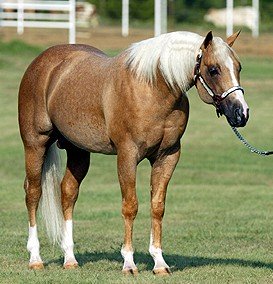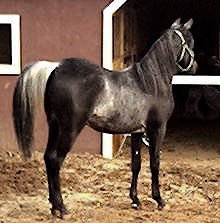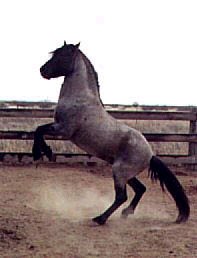Roan Horses







Roan horses have white hairs fairly evenly distributed throughout the coat of the main body, with non roaned heads and points (mane, tail, and lower legs). Roaning can give a horse’s coat a silvery effect. Roan horses can be of any color, roaning being a pattern rather than a color itself, but the contrast is more striking on dark colors. Roaning may be "masked" by gray, and can occur in combination with dun, any of the pinto or appaloosa patterns. The roan pattern may not occur until after the first foal coat is shed, but it is then stable throughout life. Roan horses don’t get lighter over the years, as gray horses do, but some get darker with age. Roan horses do change seasonally, but the lower legs, head, mane & tail will always stay colored. In the summer it may be more difficult to tell if a light colored horse is roan but the points and the head will be darker than the body. Interestingly when roan horses are injured the hair over the scars usually grows back colored, instead of the white seen with most other horses.
According to research done by Dr. Ann T. Bowling at the Veterinary Genetics Laboratory of the University of California, roan is not lethal when homozygous. Her research supports the findings of earlier reports that confirmed the existence of homozygous roan stallions in Ardennais (a French breed) and Hokkaido (a Japanese breed). From a fairly large study of roan horses in the American Quarter Horse Association (AQHA) stud book Dr. Bowling identified several stallions apparently homozygous for roan. Breeding data was supported by a molecular genetic analysis of genes very closely linked to roan. The molecular nature of the roan gene isn’t yet known, but its position in the genome is, based on its genetic linkage to nearby genes. The stallions were found to be homozygous for the alleles of these genes that are linked to the roan allele, indicating the likelihood that they are also homozygous for the roan allele. The conclusion of their research was that there was no evidence that roan is lethal when homozygous. To my knowledge this research wasn't published, although I would be grateful to anyone who could update me if this is wrong. I have also heard of critisism from one person who claims there are serious flaws in the research. According to her not all the horses in the study were true classic roans, which included frosty roans, rabicanos and sabinos. Also she claims that one of the AQHA stallions that was supposed to show 100% roan production did not. At this time I am not able to confirm or refute this information. If anyone knows more about either side of this story I would be pleased to hear from them. Many Thanks! Roan, along with dominant white, sabino-1 and tobiano have all been mapped to the KIT gene region on Chromosome 3. KIT is a large complex protein involved in many important aspects of metabolism. Some KIT mutations are homozygous lethal, including some of those causing dominant, of which there are more than one, in different horse populations. As with dominant white there may be more than one roan allele, some may be homozygous lethal, others not.
In one roaning pattern called frosty the mixture of white is more uneven than in the classic roan, with the roan areas tending to mainly be over bony prominences, such as the hip, shoulder and spine. The mane and tail tend to be roaned, and roaning can also occur on the head. Roaning may sometimes be referred to as ticking. One type of ticking that most commonly occurs in Arabs and Thoroughbreds is called coon tail (rabicano). (Rn). Rabicano horses are not true roan horses, but it may possibly be controlled by a variant allele of the roan gene. Ticking may or may not be present on the body but coon-tail ticking is always associated with horizontal white bands at the top of the tail. 






Another variant pattern called silver tail is perhaps related in some way coon tail. I’ve heard of a silver-tail bay being produced out of a “heavily roaned” chestnut mare with a skunk or coon tail (sometimes also called “brush tail”). It would be interesting to know if silver-tails ever show any other evidence of ticking, perhaps as they mature. I certainly found one example on the web of a bay Arab/Warmblood mare with what looks like a silver-tail, and with some ticking around the flanks and belly, (http://www.cyberhorse.com.au/cgi-bin/dcforum/dcboard.cgi?forum=equestrian&mark=25116&az=previous_topic&archive=yes, accessed on 19/10/2005).
Sabino horses are sometimes confused with roan. They usually have a pattern of white patches (i.e. they pinto) but most sabinos have roaning, especially those with extensive white. The roaning may not be present at birth, but can develop as a horse matures. The term sabino means "pale red" or sometimes "roan" in Spanish. However sabino is genetically distinct from roan and is caused by different genes. Minimal sabino may occur as roaning only. The roan areas on sabinos are less evenly distributed than they are on classic roans, with roaning sometimes occurring on the head and legs, which may also have white.
roan horses are described in many waysRoan horses are described using many different and striking terms, including purple roan, lilac roan and honey roan. While such names may be evocative, it’d be better to standardise the descriptions so that everyone knows what’s what, and uses the same terms in the same way! Personally I think the easiest method would be to simply add roan to the coat color, so we get black roan, bay roan, chestnut roan, palomino roan and so on. However two terms in very common and longstanding usage are blue roan and red roan.
Blue roan horses have the roaning pattern on a black base coat. The effect of the white hairs mingling with the black often causes an attractive gray or “blue” sheen to the body. The head, mane, tail and lower legs of a Black Roan will be Black. ReferenceHintz, H.F. and VanVleck, L.D. 1979. Lethal Dominant Roan in Horses. Journal of Heredity 70: 145-146.
|
|









